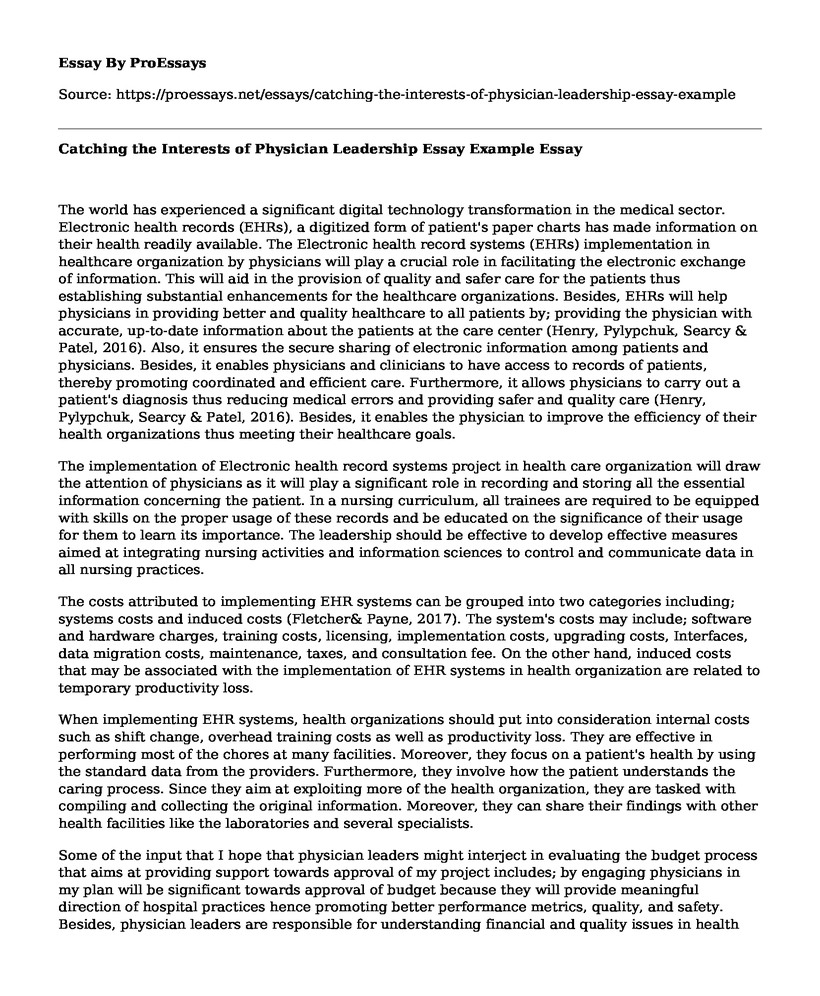The world has experienced a significant digital technology transformation in the medical sector. Electronic health records (EHRs), a digitized form of patient's paper charts has made information on their health readily available. The Electronic health record systems (EHRs) implementation in healthcare organization by physicians will play a crucial role in facilitating the electronic exchange of information. This will aid in the provision of quality and safer care for the patients thus establishing substantial enhancements for the healthcare organizations. Besides, EHRs will help physicians in providing better and quality healthcare to all patients by; providing the physician with accurate, up-to-date information about the patients at the care center (Henry, Pylypchuk, Searcy & Patel, 2016). Also, it ensures the secure sharing of electronic information among patients and physicians. Besides, it enables physicians and clinicians to have access to records of patients, thereby promoting coordinated and efficient care. Furthermore, it allows physicians to carry out a patient's diagnosis thus reducing medical errors and providing safer and quality care (Henry, Pylypchuk, Searcy & Patel, 2016). Besides, it enables the physician to improve the efficiency of their health organizations thus meeting their healthcare goals.
The implementation of Electronic health record systems project in health care organization will draw the attention of physicians as it will play a significant role in recording and storing all the essential information concerning the patient. In a nursing curriculum, all trainees are required to be equipped with skills on the proper usage of these records and be educated on the significance of their usage for them to learn its importance. The leadership should be effective to develop effective measures aimed at integrating nursing activities and information sciences to control and communicate data in all nursing practices.
The costs attributed to implementing EHR systems can be grouped into two categories including; systems costs and induced costs (Fletcher& Payne, 2017). The system's costs may include; software and hardware charges, training costs, licensing, implementation costs, upgrading costs, Interfaces, data migration costs, maintenance, taxes, and consultation fee. On the other hand, induced costs that may be associated with the implementation of EHR systems in health organization are related to temporary productivity loss.
When implementing EHR systems, health organizations should put into consideration internal costs such as shift change, overhead training costs as well as productivity loss. They are effective in performing most of the chores at many facilities. Moreover, they focus on a patient's health by using the standard data from the providers. Furthermore, they involve how the patient understands the caring process. Since they aim at exploiting more of the health organization, they are tasked with compiling and collecting the original information. Moreover, they can share their findings with other health facilities like the laboratories and several specialists.
Some of the input that I hope that physician leaders might interject in evaluating the budget process that aims at providing support towards approval of my project includes; by engaging physicians in my plan will be significant towards approval of budget because they will provide meaningful direction of hospital practices hence promoting better performance metrics, quality, and safety. Besides, physician leaders are responsible for understanding financial and quality issues in health areas. Therefore, the input and decision of physician leaders will be essential in implanting Electronic health record systems. Implementation challenges should be addressed on set so as to avoid future difficulties that occur in the process.
References
Fletcher, G. S., & Payne, T. H. (2017). Selection and implementation of an electronic health record. PM&R, 9(5), S4-S12.
Henry, J., Pylypchuk, Y., Searcy, T., & Patel, V. (2016). Adoption of electronic health record systems among US non-federal acute care hospitals: 2008-2015. ONC data brief, 35, 1-9.
Harrison, M. (2017). Future of clinical leadership: saving our greatest intensity for human beings. BMJ Leader, leader-2017.
Cite this page
Catching the Interests of Physician Leadership Essay Example. (2022, Dec 18). Retrieved from https://proessays.net/essays/catching-the-interests-of-physician-leadership-essay-example
If you are the original author of this essay and no longer wish to have it published on the ProEssays website, please click below to request its removal:
- Nursing Leadership and Advocacy Essay
- The Case for Sufficient Sleep Essay Example
- Rising Diabetes: Treatment Needed to Prevent Complications & Death - Research Paper
- Coronavirus Crisis: US Government Slow to Respond Despite Wartime Measures - Essay Sample
- Essay Example on Biological Factors in Human Behavior: COVID-19 Impact
- Paper Example on COVID-19 and the Legacy of Pandemics: Navigating Black Swans for a Brighter Future
- Free Report Example on Bergerac System







